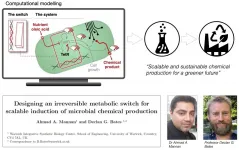Cell Reports publishes data supporting the importance of ion channel, Kv7.2/7.3 as a target in ALS
Data supports QurAlis' approach to treat hyperexcitability induced neurodegeneration in ALS patients; QurAlis gears up for clinical development of therapeutic candidate, QRL-101
2021-06-08
(Press-News.org) CAMBRIDGE, Mass.--(BUSINESS WIRE)--QurAlis Corporation, a biotech company developing breakthrough precision medicines for ALS and other genetically validated neurodegenerative diseases, today announced the publication of an article in Cell Reports titled Human Amyotrophic Lateral Sclerosis Excitability Phenotype Screen: Target Discovery and Validation by QurAlis founders Kasper Roet, Ph.D., Clifford Woolf, M.D., Ph.D., and Kevin Eggan, Ph.D., who pioneered a high-content, live-cell imaging screen using ALS patient-derived motor neurons in combination with a compound library generated by Pfizer to identify drug targets to treat hyperexcitability induced neurodegeneration in ALS patients.
The publication describes a live-cell screening strategy targeting abnormal electrophysiological properties to reveal targets that modulate the intrinsic hyperexcitability of ALS motor neurons. This unbiased screen using human ALS motor neurons identified Kv7.2/7.3 as a strongly overrepresented drug target. Dysfunction of Kv7.2/7.3 in ALS motor neurons had been previously identified by Drs. Kevin Eggan, Clifford Woolf, Brian Wainger, and Evangelos Kiskinis, which led to the development of a precision medicine program at QurAlis to develop a selective Kv7.2/7.3 ion channel opener to treat ALS patients. The validity of Kv7.2/7.3 as a drug target for ALS patients was recently also strongly supported by results of a clinical study published in JAMA Neuro showing that Kv7 modulation can decrease spinal and cortical motor neuron excitability, both of which have been linked to patient survival. Through bioinformatic deconvolution, the screen, which was a concerted effort of scientists from the Boston Children's Hospital, including shared first author Dr. Xuan Huang, The Harvard Stem Cell Institute, and the Pfizer Centers for Therapeutic Innovation also found AMPA receptors and D2 dopamine receptors as novel excitability modulating targets that contribute to ALS motor neuron excitability.
"These research results strengthen our hypothesis that the QurAlis selective Kv7.2/7.3 opener, QRL-101 (QRA-244), has the potential to be an effective therapy for patients suffering from hyperexcitability induced motor neuron degeneration," said Kasper Roet, Ph.D., CEO and Founder of QurAlis. "Previous research has identified Kv7.2/7.3 as an ALS drug target and the unbiased nature of this screen further emphasizes the importance of Kv7.2/7.3 in ALS motor neuron dysfunction."
"It is widely believed that by reducing motor neuron hyperexcitability in ALS patients, we may be able to slow the progression of the disease," said Leonard van den Berg, M.D., Ph.D., Chairman of the European Network to Cure ALS. "This study shows that excitability phenotypic screening using patient derived motor neurons is a novel and powerful method for the identification of drug targets that act on abnormal excitability and offers the potential to produce more effective therapies with fewer side effects."
INFORMATION:
Please refer to the Cell Reports publication for additional results from this study.
About Kv7.2/7.3 Ion Channel Openers
Kv7.2/7.3 is a hetero-tetrameric voltage-gated potassium channel in cell membranes which is encoded by KCNQ2 and KCNQ3. Kv7.2/7.3 is the dominant component of the neuronal M-current in human motor neurons, which stabilizes the membrane potential and controls neuronal excitability.1
Therapies that reduce abnormal electrical activity in the brain by activating or opening the Kv7.2/7.3 ion-channel show the potential to decrease spinal and cortical motor neuron excitability in patients with ALS and the potential to positively effect CMAP (compound muscle action potential) amplitude2, suggesting that this may be an effective therapeutic approach for patients suffering from hyperexcitability induced motor neuron degeneration.
About QRL-101 (QRA-244)
QRL-101 (QRA-244) is QurAlis' lead drug candidate intended to treat motor neuron hyperexcitability-induced disease progression in ALS patients, which is estimated to be up to 50% of all ALS cases. A Kv7 opener, QRL-101 has been shown in preclinical studies to have strong potential to control motor neuron hyperexcitability induced excitotoxicity with significantly fewer side effects than other drug candidates. QurAlis plans to initiate first-in-human studies of QRL-101 at the end of 2021, or the beginning of 2022.
About QurAlis Corporation
QurAlis is applying precision medicine to advance a novel therapeutic pipeline for the treatment of amyotrophic lateral sclerosis (ALS) and other genetically validated neurodegenerative diseases. The QurAlis platform enables the design and development of drugs that act directly on disease-causing genetic alterations. We are advancing three antisense and small molecule programs addressing sub-forms of ALS that account for the majority of ALS patients. QurAlis is at the leading edge of neurodegenerative research and development. For more information, please visit http://www.quralis.com or follow us on Twitter @QurAlisCo.
Sources:
1 Ihara Y, Tomonoh Y, Deshimaru M, Zhang B, Uchida T, et al. (2016) Retigabine, a Kv7.2/Kv7.3-Channel Opener, Attenuates Drug-Induced Seizures in Knock-In Mice Harboring Kcnq2 Mutations. PLOS ONE 11(2): e0150095. https://doi.org/10.1371/journal.pone.0150095
2 Wainger BJ, Macklin EA, Vucic S, et al. Effect of Ezogabine on Cortical and Spinal Motor Neuron Excitability in Amyotrophic Lateral Sclerosis: A Randomized Clinical Trial. JAMA Neurol. 2021;78(2):186-196. doi:10.1001/jamaneurol.2020.4300
Media Contact:
Sharon Correia
Executive Vice President
LaVoieHealthScience
scorreia@lavoiehealthscience.com
ELSE PRESS RELEASES FROM THIS DATE:
2021-06-08
A research team from the University of Massachusetts Amherst has created an electronic microsystem that can intelligently respond to information inputs without any external energy input, much like a self-autonomous living organism. The microsystem is constructed from a novel type of electronics that can process ultralow electronic signals and incorporates a device that can generate electricity "out of thin air" from the ambient environment.
The groundbreaking research was published June 7 in the journal Nature Communications.
Jun Yao, an assistant professor in the electrical and computer engineering (ECE) and an adjunct professor in biomedical engineering, ...
2021-06-08
DURHAM, N.C. - Using drones and artificial intelligence to monitor large colonies of seabirds can be as effective as traditional on-the-ground methods, while reducing costs, labor and the risk of human error, a new study finds.
Scientists at Duke University and the Wildlife Conservation Society (WCS) used a deep-learning algorithm--a form of artificial intelligence--to analyze more than 10,000 drone images of mixed colonies of seabirds in the Falkland Islands off Argentina's coast.
The Falklands, also known as the Malvinas, are home to the world's largest colonies of black-browed albatrosses (Thalassarche melanophris) and second-largest ...
2021-06-08
Researchers from the University of Liège (Belgium) have recently developed a new artificial neuron inspired by the different modes of operation of human neurons. Called a Bistable Recurrent Cell (BRC), this process has enabled recurrent networks to learn temporal relationships of more than a thousand discrete time units where classical methods failed after only a hundred time units. These important results are published in the journal PLOS One.
The enormous interest in artificial intelligence (AI) in recent years has led to the development of extremely powerful machine learning techniques. For example, time series - any series of data where a time component is ...
2021-06-08
The speed of water flow is a limiting factor in many membrane-based industrial processes, including desalination, molecular separation and osmotic power generation.
Researchers at The University of Manchester's National Graphene Institute (NGI) have published a study in Nature Communications showing a dramatic decrease in friction when water is passed through nanoscale capillaries made of graphene, whereas those with hexagonal boron nitride (hBN) - which has a similar surface topography and crystal structure as graphene - display high friction.
The team also demonstrated that water velocity could be selectively controlled by covering the high friction hBN channels with graphene, opening ...
2021-06-08
DURHAM, N.H.--Why did the deer cross the road? According to research from the University of New Hampshire to keep going and going and going. Researchers have discovered the longest distance ever recorded by an adult male white-tailed deer--300 kilometers, or close to 200 miles, in just over three weeks. The finding has important implications for population management and the transmission of disease, especially chronic wasting disease, a fatal neurological disease.
"Deer are one of the most abundant, well-known and intensely managed species of wildlife in the United States," said Remington Moll, assistant ...
2021-06-08
The bad odors produced by the Waste Water Treatment Plants, known as WWTPs, have become a growing concern in the cities and towns that host these facilities and are considered by citizens to be the main cause of the perception of pollution, along with the dust and noise.
Now, and thanks to a collaboration between the Institute for Bioengineering of Catalonia (IBEC) and the company DAM, a new way is being opened to detect and treat these odors.
According to the researchers, "the results obtained in the SNIFFDRONE project (Odor monitoring by drones for environmental purposes) are very positive and represent a significant advance ...
2021-06-08
- Most high-value chemicals are currently produced using fossil fuels - industrial chemistry's use of petroleum accounts for 14% of all greenhouse gas emissions.
- An exciting alternative is to engineer bacteria as "cell-factories" with a genetic switch that reroutes their chemistry to produce high-value chemicals, such as biofuels, polymers and pharmaceuticals.
- The use of expensive chemicals to switch them on severely limits their commercial potential, researchers have used mathematical models to develop a new genetic switch that can use a cheap natural ...
2021-06-08
JUNE 8, 2021, NEW YORK - A study conducted by researchers at the Ludwig Center at Harvard has demonstrated how a drug screening method known as dynamic BH3 profiling can be used to quickly identify potentially effective combinations of existing drugs for personalized cancer therapy.
"We know that cancer cells and healthy cells have different metabolisms," said Ludwig Harvard investigator Anthony Letai who, with former postdoctoral researcher Veerle Daniels, led the study reported in the current issue of Science Signaling. "Using BH3 profiling, we found a specific metabolic dependency in triple ...
2021-06-08
Published monthly, the journal CHEST® features peer-reviewed, cutting-edge original research in chest medicine: Pulmonary, critical care, sleep medicine and related disciplines. Journal topics include asthma, chest infections, COPD, critical care, diffuse lung disease, education and clinical practice, pulmonology and cardiology, sleep and thoracic oncology.
The June issue of CHEST includes 95 articles, clinically relevant research, reviews, case series, commentary and more. Each month, the journal also offers END ...
2021-06-08
A new Alzheimer's disease drug will hit the market soon, the first in nearly two decades. But some experts say the evidence for it isn't terribly strong and worry that it may cost a lot.
Still, the announcement of its approval by the U.S. Food and Drug Administration made headlines nationwide. The attention reflects the toll dementia takes on patients, families and society, and the lack of good treatment options.
Meanwhile, millions of adults could lower the chance that they'll ever need a drug like that. To do so, they will need to work with their primary care providers and use the power ...
LAST 30 PRESS RELEASES:
[Press-News.org] Cell Reports publishes data supporting the importance of ion channel, Kv7.2/7.3 as a target in ALS
Data supports QurAlis' approach to treat hyperexcitability induced neurodegeneration in ALS patients; QurAlis gears up for clinical development of therapeutic candidate, QRL-101






